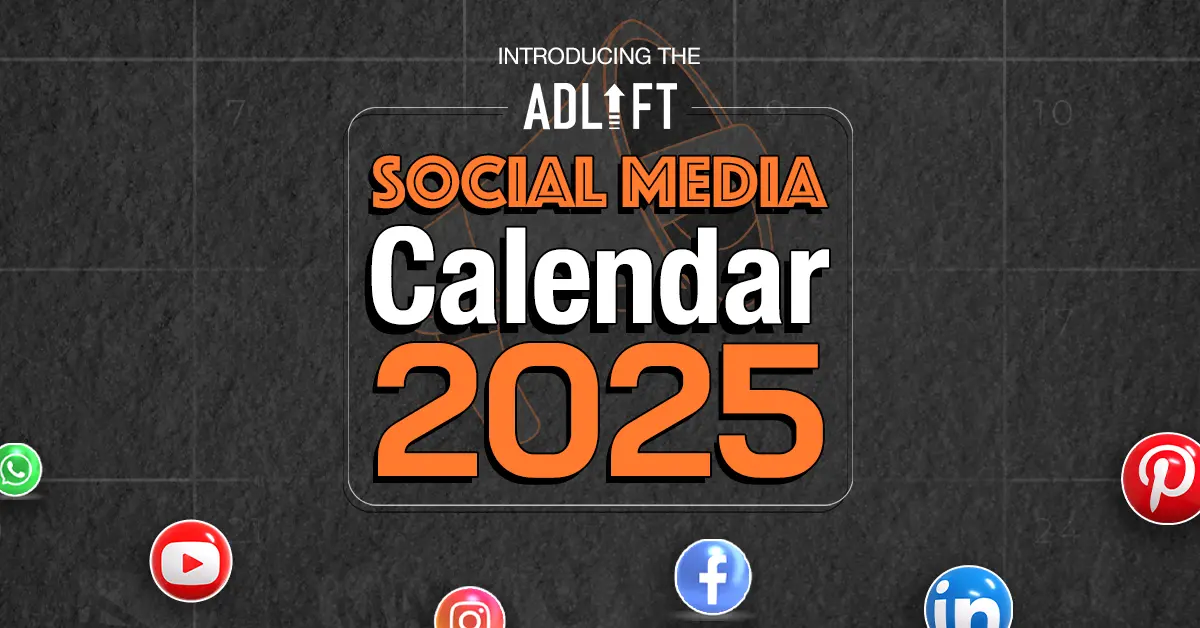AdLift’s 2025 Social Media Calendar: Your Roadmap to Success

As we step into 2025, we’ll be surrounded by major global events like the FIFA World Cup in Canada, the United States, and Mexico, the Paris Climate Summit, The World Economic Forum, and the Summer Olympics in Paris, amongst others dotting our calendars. For a brand, leveraging the right event to keep up with its audience’s interests will be key. A well-structured social media calendar is necessary to seize these moments effectively.
Without a well-structured social media calendar, even the best ideas risk fading into the noise. Are you ready to craft a strategy that makes your brand part of the conversation rather than just an observer? To avoid major FOMO, let’s plan 2025 with precision and purpose.
Why a Social Media Calendar is a Game-changer for 2025
Stay Ahead with Trends
2025 will be a landmark year for social media, with key trends shaping the way brands communicate:
- The Rise of AI-generated Content: AI tools like ChatGPT and Gemini are revolutionizing content creation, allowing brands to produce personalized and scalable content at unprecedented speed.
- Short-form Video Dominance: Platforms like TikTok, Instagram Reels, and YouTube Shorts continue to captivate audiences with bite-sized, engaging content that drives higher interaction rates.
- Platform-specific Content Strategies: Tailoring content to each platform’s unique audience and format will be essential for brands to remain relevant and resonate deeply with users.
Overcoming Common Challenges
Many brands struggle with consistency, last-minute content creation, and maintaining a cohesive voice. A well-planned social media calendar helps to:
- Ensure regular posting across platforms.
- Allocate time for brainstorming, production, and optimization.
- Align all campaigns with overarching brand goals and global events.
- Minimize stress and inefficiencies in content production.
Audience Insights: Know Your Audience Like Never Before
Tips for Targeting Specific Demographics Effectively
Instagram:
- Focus on visually stunning content for Millennials and Gen Z.
- Leverage Stories, Reels, and interactive polls to boost engagement.
- Partner with micro-influencers for authentic outreach. According to a recent study, 69% of consumers rely on influencer recommendations when making purchase decisions, and businesses are earning $5.78 for every $1 spent on influencer marketing.
-
LinkedIn:
- Share thought leadership articles and case studies to resonate with professionals.
- Target decision-makers through precise ad campaigns and sponsored posts.
- Use LinkedIn’s analytics tools to refine audience targeting and messaging.
-
TikTok:
- Engage with Gen Z using humorous, trend-driven content.
- Collaborate with influencers for authentic outreach and broader reach.
- Post regularly during peak hours to capitalize on high engagement windows.
-
YouTube:
- Provide educational and how-to videos for a broad audience.
- Focus on Shorts to capture younger viewers while creating evergreen content for long-term engagement.
- Optimize video descriptions, tags, and thumbnails to improve search visibility.
-
Facebook:
- Use groups to foster community discussions around niche topics.
- Engage older demographics with curated articles and event promotions.
- Incorporate live streams for real-time engagement and brand storytelling.
AI Integration Tips: Supercharge Your Social Strategy
How to Incorporate AI Tools into Your Workflow?
Content Generation:
- Use AI to draft captions, blogs, and even visual assets for social media.
- Tools like Jasper, Canva’s AI design features, and Adobe Firefly can help you save time while ensuring creativity and consistency.
-
Analytics and Optimization:
- AI-powered platforms like Sprout Social and Hootsuite can analyze audience engagement and recommend optimal posting times.
- Use AI for sentiment analysis to refine your messaging strategy and detect trends early.
-
Chatbots for Engagement:
- Employ AI chatbots on platforms like Instagram and Facebook Messenger to enhance customer interaction and streamline query resolution.
Ad Personalization:
- Use AI to craft hyper-personalized ad copy and target segments with precision.
- Predict audience behavior using AI-driven insights to optimize future campaigns.
Metrics to Watch: Measure What Matters
Engagement Rate: Likes, Comments, Shares, and Saves
Engagement rate is one of the most critical metrics to measure because it directly reflects how your audience interacts with your content. High engagement indicates that your posts resonate with your audience, prompting them to like, comment, share, or save.
For 2025, brands should focus on creating content that invites participation, such as polls, quizzes, or comment prompts. Additionally, tracking trends in engagement over time can help you identify what type of content performs best and refine your strategy accordingly.
Reach and Impressions: Measure Content Visibility
Reach and impressions measure how far your content is spreading and how often it is seen. Reach refers to the unique number of users who have viewed your content, while impressions count the total number of times it has been displayed, including multiple views by the same user.
Monitoring these metrics helps you understand the effectiveness of your distribution strategy and identify opportunities to expand your audience. For example, a low reach could indicate a need for better hashtag strategies or ad targeting.
Click-through Rate (CTR): Effectiveness of Your Call-to-Action
CTR measures the percentage of users who click on a link within your post, ad, or story compared to the number of impressions. It’s an essential metric for assessing the strength of your call-to-action (CTA). A high CTR indicates that your CTA is compelling and aligned with audience interests. To boost CTR, brands can experiment with action-oriented language, eye-catching visuals, and urgency-driven tactics, such as limited-time offers or exclusive content.
Conversion Rate: Turning Engagement into Results
Conversion rate tracks how well your campaigns drive specific actions, such as purchases, sign-ups, or downloads. This metric is particularly vital for brands focused on measurable outcomes.
A strong conversion rate suggests that your content not only engages but also convinces users to take the next step. To optimize conversion rates, ensure that landing pages are user-friendly, CTAs are clear, and the messaging is consistent across all touchpoints.
Platform-specific Metrics: Tailored Insights for Each Channel
Each social media platform offers unique metrics that reflect user behavior. On YouTube, for instance, watch time and video completion rates are crucial for understanding content performance. On Instagram, Story views and interaction rates (e.g., replies or sticker taps) provide insights into ephemeral content’s effectiveness.
TikTok metrics like follower growth and hashtag performance indicate the impact of short-form videos. By focusing on these platform-specific metrics, brands can fine-tune their strategies to meet audience expectations and platform algorithms.
Sentiment Analysis: Gauge Audience Perception
Sentiment analysis evaluates how your audience feels about your brand, content, or campaigns. By analyzing comments, reviews, and mentions, brands can measure positive, negative, or neutral sentiments. This metric is invaluable for understanding brand perception and addressing potential issues before they escalate.
In 2025, leveraging AI tools for real-time sentiment tracking will allow brands to respond swiftly to audience concerns and maintain a positive image.
Key Highlights for 2025
Platform-specific Recommendations
Instagram: Mastering Visual Storytelling
Reels and Stories: Prioritize short, engaging videos to tap into Instagram’s algorithm.
Algorithm Updates: Post consistently and encourage Saves and Shares to boost visibility.
Community Building: Use interactive features like Q&A stickers, polls, and collaborative posts to foster deeper connections.
LinkedIn: Engage Professionals Effectively
Thought Leadership: Publish long-form content to establish authority in your niche.
LinkedIn Groups: Participate in or create groups to engage with professionals in your industry.
Recruitment Campaigns: Use advanced targeting to connect with top talent and showcase company culture.
TikTok: Stay Ahead in the US Market
Emerging Trends: Jump on viral challenges and use trending sounds to increase reach.
Interactive Content: Encourage user participation through Duets, Stitches, and hashtag challenges.
Niche Communities: Collaborate with creators who align with your brand values to build authentic connections.
YouTube: Leverage Shorts and Evergreen Content
Shorts: Post consistently to gain traction with younger audiences and capitalize on YouTube’s emphasis on short-form content.
Evergreen Content: Invest in high-quality tutorials, reviews, and explainer videos.
SEO Optimization: Use keywords, timestamps, and playlists to improve discoverability and drive long-term traffic.
Facebook: Maximize Versatility
Live Streams: Host interactive sessions to discuss products, events, or industry trends.
Video Ads: Leverage autoplay ads to capture attention in the feed.
Local Targeting: Use geotargeting to promote events or special offers to local audiences.
Creating a Social Media Calendar for 2025: Step-by-Step
Map Out Key Events: Align your campaigns with global events like the FIFA World Cup, Earth Day, Summer Olympics, and major holidays.
Define Your Goals: Identify what you want to achieve—brand awareness, lead generation, or engagement.
Plan Content Themes: Create monthly themes to ensure cohesive storytelling and consistent messaging.
Allocate Resources: Assign roles for content creation, scheduling, and analytics.
Schedule and Automate: Use tools like Hootsuite, Buffer, or SocialBee to schedule posts in advance and save time.
Track and Optimize: Regularly review performance metrics, test different content types, and adjust your strategy as needed.
AdLift’s 2025 Social Media Calendar: Your Go-to Resource
AdLift’s 2025 social media calendar is designed to:
- Provide a comprehensive overview of important dates and trends.
- Help brands plan campaigns around global events and platform-specific opportunities.
- Streamline the content creation process, ensuring consistency and quality.
- Offer tailored recommendations for each platform to maximize engagement and ROI.
Get Ready for 2025 with AdLift!
The digital scene is evolving at lightning speed, but with the right tools and strategies, your brand can thrive. AdLift’s 2025 social media calendar is more than just a planning tool; it’s your roadmap to success. Stay ahead of the curve by leveraging the latest trends, integrating AI tools, and crafting platform-specific content that resonates with your audience.
Ready to make 2025 your most impactful year yet? Download AdLift’s 2025 Social Media Calendar today and take the first step toward achieving your social media goals.
Categories
Recent Posts
- Boost Your Website’s Visibility with These Must-have B2B SEO Tools January 13, 2025
- Master Your Digital Strategy: Learn the 7 Types of SEO That Lead to High Rankings January 13, 2025
- 2024: A Year to Remember at AdLift! January 7, 2025
- How to integrate your SEO and paid search strategies to maximize efficiency and reduce CAC January 6, 2025
- SEO in 2025: Adapting to a Changing Search Landscape By Prashant Puri, CEO & Co-Founder, AdLift January 3, 2025
- Understanding the Google December 2024 Spam Update: What You Need to Know December 31, 2024
- Beware of Ongoing Scams Involving Fake AdLift Representatives December 31, 2024
- Facebook vs Twitter: Which Platform Wins for Your Marketing Goals? December 30, 2024
- The Art of Naming Conventions in Marketing Campaigns: Best Practices for Clarity and Success December 26, 2024
- Is Your Content Strategy Working for You — or Against You? December 19, 2024
Get
in Touch
Contact AdLift for a 360-degree marketing plan




